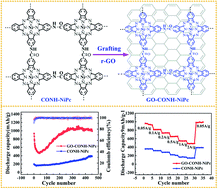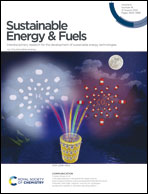Phthalocyanine polymer grafted graphene oxide matrix as high-performance anode material for lithium-ion batteries†
Abstract
In order to solve the problems of high solubility in electrolytes, low active sites, and poor lithium-ion transport channels in organic electrode materials, in this study, CONH-NiPc and GO-CONH-NiPc polymers were synthesized by the amide reaction and characterized as negative materials for rechargeable lithium-ion batteries (LIBs). The energy dispersive spectrometer (EDS) test results indicated that the CONH-NiPc polymer was grafted onto the graphene oxide substrate uniformly. The initial discharge capacity of CONH-NiPc electrodes was 197 mA h g−1 at a current density of 200 mA g−1 after 450 cycles, the discharge capacity increased to (385 mA h g−1) with a retention rate of 195.5%. However, at the same current density, the initial discharge capacity of the GO-CONH-NiPc electrode was 934 mA h g−1, which was much higher than that of CONH-NiPc 197 mA h g−1; after 450 cycles, the discharge capacity remained at 1021 mA h g−1 with a retention rate of 109%. CONH-NiPc grafting onto graphene oxide substrate not only reduces the solubility of active substances in the electrolyte but also effectively disperses the aggregation of phthalocyanine units, increases the specific surface area to expose more active sites, and improves the transmission channel of lithium ions, which gives the reason that the GO-CONH-NiPc displays better electrochemical behavior. The strategy of grafting phthalocyanine molecules onto graphene opens up a new approach for electrode materials in rechargeable lithium-ion batteries.



 Please wait while we load your content...
Please wait while we load your content...